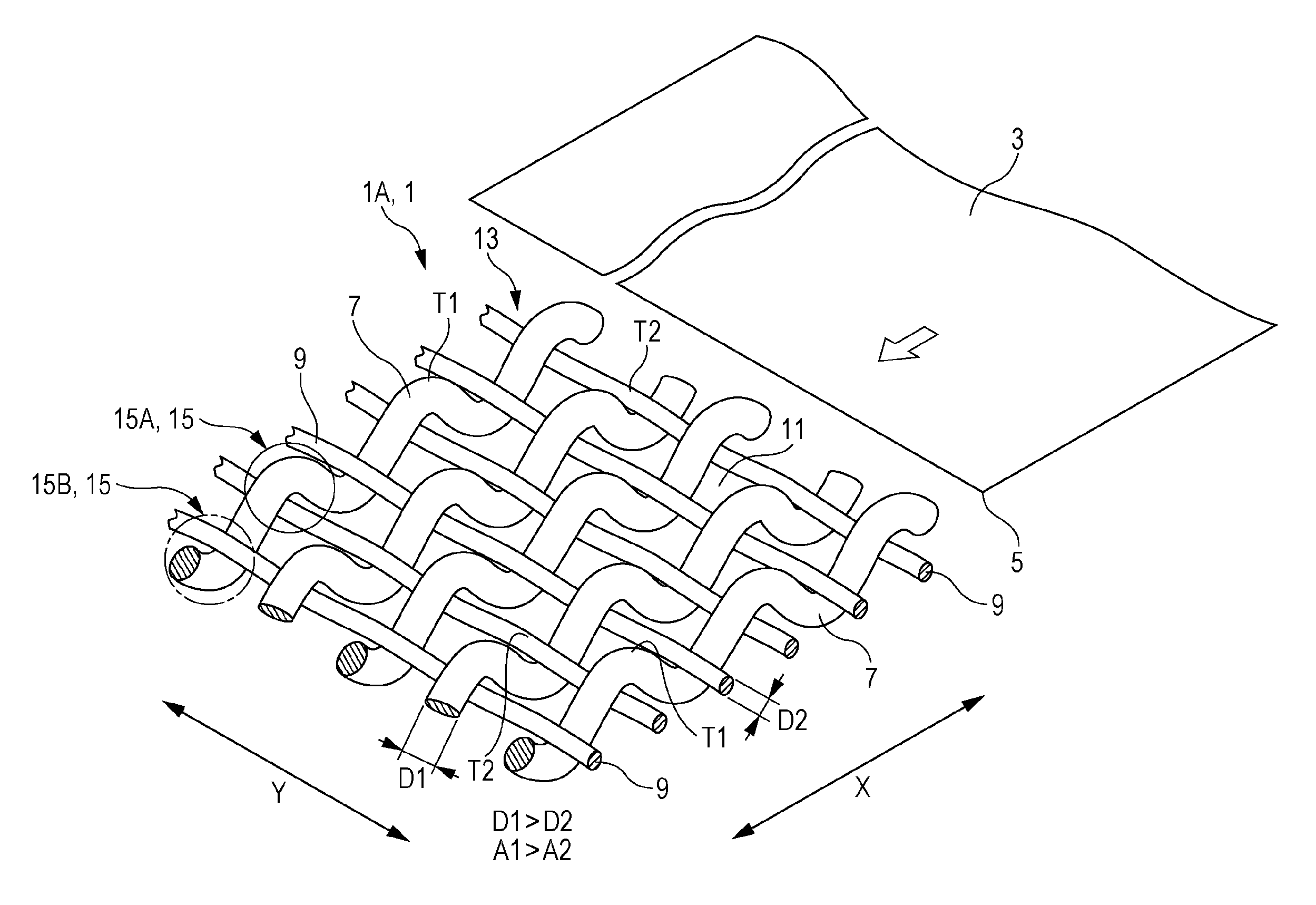Mesh member, method of producing mesh member, and liquid discharging apparatus
- Summary
- Abstract
- Description
- Claims
- Application Information
AI Technical Summary
Benefits of technology
Problems solved by technology
Method used
Image
Examples
first embodiment
[0053]A first Embodiment will be described with reference to FIGS. 1 to 3B and types A, E, and F in FIG. 7. A mesh member 1 according to an aspect of the invention includes first strands 7 extending in a first direction X and second strands 9 extending in a second direction Y intersecting the first direction X. The first strands 7 and the second strands 9 are woven together to cross over and under each other and form a mesh structure 13. In the mesh member 1, the first strands 7 each have a cross-sectional area A1 that is larger than a cross-sectional area A2 of each second strand 9 at intersections 15 where the first strands 7 and the second strands 9 cross each other.
[0054]In a mesh member 1A in the first embodiment, the first strand 7 has a diameter D1 larger than a diameter D2 of the second strand 9. This enables the first strand 7 to have a cross-sectional area A1 larger than a cross-sectional area A2 of the second strand 9.
[0055]In this embodiment, the mesh member 1A is made o...
second embodiment
[0063]A second embodiment will be described with reference to FIGS. 4A to 4C, 5A, and 5B, and to types B and C in FIG. 7. In a mesh member 1B in the second embodiment, at the intersections 15, where the first strands 7 and the second strands 9 intersect, the first strands 7 each include a bundle of strands and the second strand 9 includes one strand or a bundle of strands. The number of strands in the second strand 9 is smaller than the number of strands in the first strand 7. This allows the first strand 7 to have a larger cross-sectional area A1 than the cross-sectional area A2 of the second strand 9 in the mesh structure 13.
[0064]In FIGS. 4A to 4C, 5A, and 5B, and in the type B in FIG. 7, the first strand 7 is a bundle of two strands and the second strand 9 includes one strand, and the diameter D1 of each strand in the first strand 7 and the diameter D2 of the strand in the second strand 9 are the same. In the mesh member 1B having the above configuration, as indicated by the typ...
third embodiment
[0069]A third embodiment will be described with reference to FIGS. 6A to 6C and to type D in FIG. 7. In a mesh member 1C in the third embodiment, the first strand 7 has a cross-sectional area A1 larger than a cross-sectional area A2 of the second strand 9, and an interval P1 between adjacent first strands 7 is smaller than an interval P2 between adjacent second strands 9. In FIGS. 6A to 6C and in the type D in FIG. 7, as in the first embodiment, the diameter D1 of the first strand 7 is larger than the diameter D2 of the second strand 9. Thus, the equation D1>D2, in which D1 and D2 are the diameters of the first strand 7 and the second strand 9, respectively, is satisfied. Accordingly, the equation A1>A2, in which A1 and A2 are the cross-sectional areas of the first strand 7 and the second strand 9, respectively, is also satisfied. Additionally, in this embodiment, an equation P12, in which P1 is an interval between adjacent first strands 7 and P2 is an interval between adjacent seco...
PUM
| Property | Measurement | Unit |
|---|---|---|
| Fraction | aaaaa | aaaaa |
| Fraction | aaaaa | aaaaa |
| Diameter | aaaaa | aaaaa |
Abstract
Description
Claims
Application Information
 Login to View More
Login to View More - R&D Engineer
- R&D Manager
- IP Professional
- Industry Leading Data Capabilities
- Powerful AI technology
- Patent DNA Extraction
Browse by: Latest US Patents, China's latest patents, Technical Efficacy Thesaurus, Application Domain, Technology Topic, Popular Technical Reports.
© 2024 PatSnap. All rights reserved.Legal|Privacy policy|Modern Slavery Act Transparency Statement|Sitemap|About US| Contact US: help@patsnap.com










